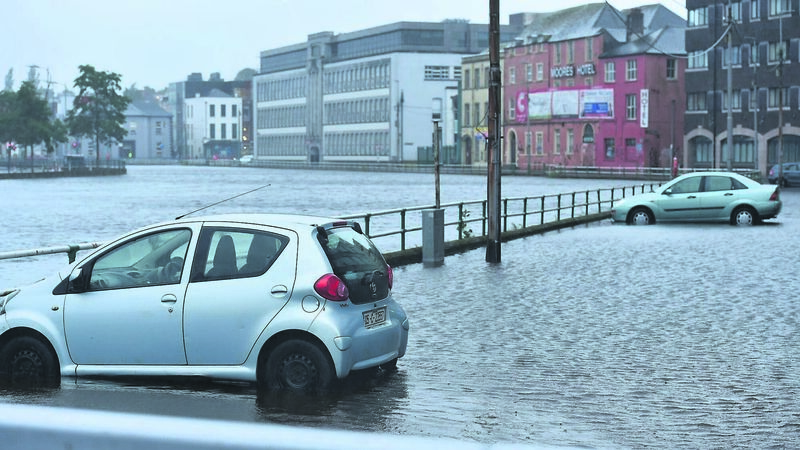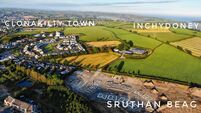Ann Doherty: It's time for flood defences in Cork city

Cork has been scourged by flooding in recent years and business people in the city are fed up of mopping up their premises after flooding of the Lee.
In recent weeks, Cork’s Prince's Street has rightly been presented as an exemplar of how business can imaginatively function in the midst of the Covid-19 pandemic.
The collaboration of restaurants, bars, retailers, and Cork City Council created an open and vibrant trading street, a template taken up by many streets in the city and envied by other towns and cities.
But were it not for a change of wind direction from southeasterly to southerly on the afternoon of Thursday, August 20, Prince's Street would have been badly flooded and its businesses damaged again - some probably irretrievably – and the progress achieved in recent months set to naught.
The same fate also awaited many other streets in the city centre including Oliver Plunkett Street, Pembroke Street, and Cook Street.
The stakes at play in the further obstruction of the Morrison’s Island public realm and flood defence scheme cannot be laid out more starkly than through those events of August 20.
On that day, morning forecasts indicated a risk of flooding on a par with that experienced in February 2014.
Businesses, hanging on by a thread through the resilience and determination of owners and staff, are now confronted by the prospect of legal challenges to the project. These businesses will continue to operate at serious risk, uninsurable and uncertain, while objectors prevent a solution to flooding.
That solution, the Morrisons Island scheme, was the subject of a full public consultation, review and amendment.
There is public consultation on all proposed infrastructural projects in the city, and differing views are considered. Inevitably, even after public consultation, not everything approved will find universal agreement and some will be disappointed.
But surely those who want critical infrastructural projects to proceed expeditiously also have rights; the right to personal safety, the right to live in the city centre and to carry out business without the ever present threat of flooding, the right to business continuity?
Stripped down, the Save Cork City (SCC) campaign’s narrative, not just in relation to the Morrison’s Island project but also to the Lower Lee Flood Relief Scheme (LLFRS) relies on a single ‘article of faith’: a philistine city council that has no regard for heritage, history or culture is responsible.
My response to that is simply: “Please look around you”. The city council has led on projects such as St Peter’s on North Main Street, Fenns Quay, Blackrock Castle Observatory, Old Cork Waterworks, Elizabeth Fort, and has facilitated or partnered on the refurbishment of Boole House, Frank O’Connor House, Civic Trust House, Washington Street Courthouse and Nano Nagle Place.
The Morrison’s Island scheme will end the use of the riverside as a giant car park. It will create a three-metre wide quayside promenade and enable people to enjoy the area. It provides an opportunity for broader regeneration.
SCC presents itself as having a unique insight of flood defence and climate change beyond those State agencies and international consultants charged with and accountable for the delivery of defence schemes.

This has led them to posit a solution to the problem of flooding in Cork city centre and the wider Lee catchment - a tidal barrier at Little Island.
SCC’s own consultants, HR Wallingford, contrary to the impression created, did not design the barrier or recommend its location at Little Island, or provide, as has been claimed, “cost certainty” for such a barrier.
In fact, before HR Wallingford demanded that SCC stop misrepresenting its report, they recommended that detailed hydrodynamic, navigational safety and environmental assessment be carried out to come to an informed view on the tidal barrier.
The only detailed pre-feasibility study on the matter was carried out by LLFRS and its 200-page study points out that a tidal barrier at Little Island is not viable on the grounds of navigational safety, environmental impacts, climate change adaptability, and cost. While a correctly sited and designed tidal barrier, if or when required, could resolve the tidal problem, it would not address the river flooding problem in the city.
Still, this notion of a “silver bullet” in the form of a tidal barrier persists and continues to be promulgated by SCC. It appears that SCC wants to set aside a quantum of work undertaken by teams of international experts over 13-years, which has been peer reviewed and internationally validated, in favour of a tidal barrier proposition that fails on all serious technical criteria.
It is also worth noting every substantive issue raised in submissions received during the public consultation phase of LLFRS was addressed in the scheme exhibition report (including appended reports), which was made publicly available in December 2017.
SCC will object to anything that does not meet its preferences. It will delay and litigate against all such projects, regardless of public consultation, Bord Pleanála decisions, international peer review, the common good.
But is it reasonable, fair and proportionate? No, it is not.
The Docklands to City Centre Road Network Scheme is also in SCC’s cross hairs. Proposed by Cork City Council to provide a gateway to the docklands and to provide significantly improved facilities for bus passengers, cyclists and pedestrians as well as introducing new amenities to the area, it is a high quality, environmentally friendly and sustainable project.
Yet SCC opposes it on the basis that it includes a minor flood defence element to which it objects. It does not seem to accept that Cork City Council is obliged to have regard to flood risks when providing new amenities or public realm enhancements in low lying areas and to respond appropriately to those risks.
And on and on it goes.
SCC doesn’t want the Morrison’s Island Public Realm project, the Docklands to City Centre Road Network Scheme, or LLFRS. It only wants what it wants.
I see little point in purporting to “Love the Lee” and allowing its waters to lap around the ankles of those who are trying to make a living.
Cork city centre will continue to flood until effective defences are in place.
When serious flooding happens again, as it certainly will, it will be interesting to see whether those opposed to these schemes will be seen shoulder to shoulder with City Council staff, residents and business owners working throughout the night to save homes and businesses.
Will they be there mopping up premises and what words of comfort will they offer beleaguered traders once more brought to their knees by avertable flooding?












